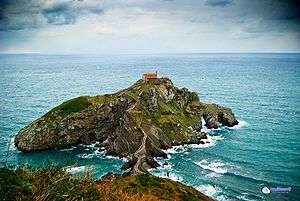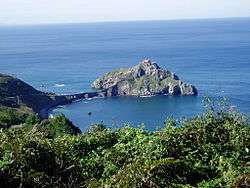Gaztelugatxe

Gaztelugatxe is an islet on the coast of Biscay belonging to the municipality of Bermeo, Basque Country (Spain). It is connected to the mainland by a man-made bridge. On top of the island stands a hermitage (named Gaztelugatxeko Doniene in Basque; San Juan de Gaztelugatxe in Spanish), dedicated to John the Baptist, that dates from the 10th century, although discoveries indicate that the date might be the 9th century. With another small neighboring island, Aketze, they form a protected biotope that extends from the town of Bakio until Cape Matxitxako, on the Bay of Biscay.
The best seasons to visit are spring and autumn.
Etymology
The word gaztelugatxe comes from the Basque gaztelu = "castle" and aitz = "rock" or "crag", forming "crag of the castle".
Description

The Basque coast is rough in this area. The sea ceaselessly erodes the rocky coast creating tunnels, arches and caves. The island of Gaztelugatxe is in the center of this section of coast next to the small Aketze island (Island of Rabbits) a paradise for marine birds.
Next to the hermitage there is a small shelter that lets people take refuge from the wind and picnic surrounded by the sea views.
The hermitage is accessed by a narrow path, crossing the solid stone bridge, and going up 237 steps (other sources cite the number as 229 or 231). According to legend, after the slightly strenuous climb to the top of the crag one should ring the bell three times and make a wish.
The hermitage
The small church dates from the 10th century and seems to have come from the Knights Templar. In the year 1053 it was donated, by don Iñigo López Lord of Biscay, to the monastery of San Juan de la Peña near Jaca in Huesca. Medieval burials from the 9th and 12th centuries have been found on the esplanade and in the hermitage.
In 1593 it was attacked and sacked by Francis Drake. Among other incidents, it has caught fire several times. On November 10, 1978, it was destroyed in one such fire. Two years later, on June 24, 1980 it was re-inaugurated. The hermitage belongs to the parish of San Pelayo in Bakio.
The hermitage also houses votive offerings from sailors who survived shipwrecks.
Strategic uses
The strategic location of the site has given it an important role in historic episodes. It was one of the places where the Lord of Biscay, Juan Núñez de Lara, confronted Alfonso XI, King of Castile, in 1334.
In 1594 it was attacked by the Huguenots of La Rochelle, who sacked it and killed the caretaker. In the 18th century it was assaulted by English troops; in the Spanish Civil War the naval Battle of Matxitxako took place nearby.
Gallery
-

Gaztelugatxe
-

Gaztelugatxe
-

Gaztelugatxe
-

Gaztelugatxe, the church
-

Gaztelugatxe
-

Gaztelugatxe
-

Gaztelugatxe
-

Gaztelugatxe
-

Gaztelugatxe
-

Stairs
-

Stairs
-

Stairs
External links
| Wikimedia Commons has media related to Gaztelugatxe. |
- Gaztelugatxe, Bermeo Town Council website.
Coordinates: 43°26′49″N 2°47′06″W / 43.447°N 2.785°W